 Return to
Return toAviation Answer-Man
Gateway
 Return to
Return to
Aviation Answer-Man
Gateway
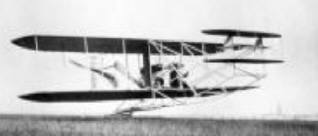 Return to
Return to
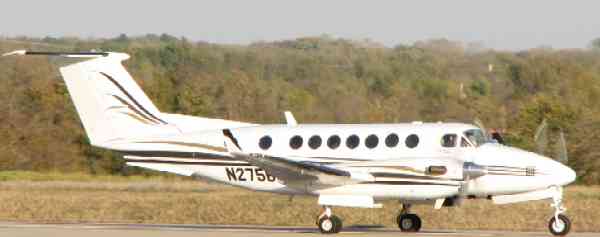
It's a very hot topic these days in Wichita: What is going to happen with Hawker-Beechcraft (HBC)?  One of the city's (and America's) oldest continuously active aircraft manufacturers, the company has fallen into hard times, and is (as of this writing, July 2012) currently in bankruptcy proceedings.
One of the city's (and America's) oldest continuously active aircraft manufacturers, the company has fallen into hard times, and is (as of this writing, July 2012) currently in bankruptcy proceedings.
A peek into the company's past helps one understand how it got to this point, and where the future may be. This legendary leading aircraft manufacturer-- of light-planes, business aircraft, mini-airliners, military trainers and target drones -- employs over 4,000 Wichita-area locals and 2,500 in other cities, states and countries (including maintenance facilities worldwide) -- down from a peak of over 10,000.
The Beginning
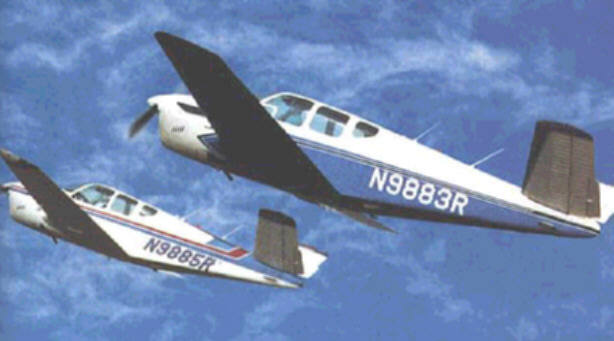
In the early postwar years, Beech re-defined light aircraft standards with the speedy V-tailed Beech Bonanza -- introducing a sleek, efficient mix of all-metal construction, refined aerodynamics, retractable, tricycle landing-gear, and roomy interior that has served, ever since, as the industry's benchmark single-engine "business plane" -- the longest continuously produced aircraft design in the world.
Walter Beech's death in 1950 left the company in the
hands of his indomitably tough,
capable wife, businesswoman Olive Ann Beech
(often called the "First Lady of Aviation"), and nephew Frank
Hedrick. Olive Ann was especially shrewd and tenacious in maintaining the
Beech brand's industry-leading reputation for quality, luxury and grandeur.
She also maintained the Beech family tradition of corporate paternal interest in the welfare
of Beech workers -- popularly known as "Beechcrafters"
In the 1950s and 1960s, with its growing brand-reputation as "the Cadillac of Light Planes," Beech began evolving the Bonanza into a family of light and cabin-class twin-engine planes, culminating in the pressurized, twin-turboprop Beech King Air -- immediately (and ever since) the leader in turboprop executive aircraft.
As the King Air grew
Beech's long history with the U.S. military has been one of the factors most distinuishing it from other general aviation aircraft manufacturers.
Since its first model, Beech planes have served the military as light transports, trainers, reconnaisance aircraft, and more -- integrating almost the entire Beech general aviation aircraft line with military applications.
Indeed, some of Beech's civilian aircraft were reportedly developed with an eye to military applications at the time of their development, with military funding.
In the late 1960s, at the height of the Vietnam War, Beech's Bonanza was modified into one of the nation's first pilotless "drone" spy-planes, as the QU-22.
And Beech developed a "Missile Systems Division"
Over the subsequent years, most major Beech models have been utilized by the military for liaison aircraft, light utility transports, remote-sensing, aerial surveillance and/or airborne command posts, and other roles. Beech's "Special Missions" program -- involving most Beech engineers at one time or another -- adapts its aircraft to military roles for the U.S. and other nations.
The T-6A was also picked by the Air Force to replace its aging Cessna T-37 intermediate jet trainers. Now, all U.S. military pilots train in Beech aircraft. Additionally, those trainees
And so it is that Hawker-Beechcraft -- even through its "civilian" aircraft line -- continues to be interwoven deeply into the fabric of American military airpower.
Jockeying for Jets At the upper reaches of the product line, though, in the
realm of business jet aircraft ("bizjets"), Beech has always
struggled to maintain position against competitors.
First, in the 1950s, came the French-made Morane-Saulnier MS.760 Paris Jet, a modified military jet trainer that squeezed a pilot and three passengers into a stretched small military jet (technically, the world's first business jet). Beech tried, unsuccessfully, to market it in the U.S. (the French fared little better abroad). In the 1960s and 1970s, though, the bizjet market was flooded with competitors, ranging from Beech's cross-town rivals Cessna and Learjet, to international and big-jet competitors Gulfstream, Dassault (Falcon), and Bombardier/Canadair (Challenger, Global Express). As Beech's executive clientele worked their way up the company's extensive product line -- from light singles, to light twins, to cabin twins, to pressurized turboprops, they reached a point at which they had to leave Beech behind, if they wanted to step up into jets. For
many years, Beech looked abroad for solutions.
In the mid-/late-1960s, a partnership with Britain's Hawker-Siddley, Ltd. was moderately successful, relabeling some of the popular HS-125 mid-sized business jets as the "Beech-Hawker BH-125" for sale by Beech in the U.S., while the Hawkers retained their native name elsewhere. 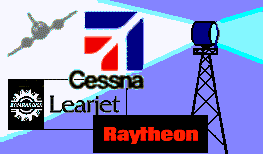
Competition at the low end of the jet market (chiefly from
local competitors Learjet and Cessna)

Aging UNgracefully However, despite success in jets, Beech's product line was showing its age by the mid-1980s. Except for the Beechjet 400A (Japanese Mitsubishi Diamond) and T-6A Texan II trainer (Swiss Pilatus PC-9), all the Beech aircraft were essentially based on 20-year-old designs, or older -- much older.
Beech's popular, grand, turboprop-twin
At the same time, labor costs and crash-lawsuits were growing -- and the Beech family dynasty was aging to incapacity. Beech needed help to deal with the challenges.
Almost from the start, the relationship was problematic.
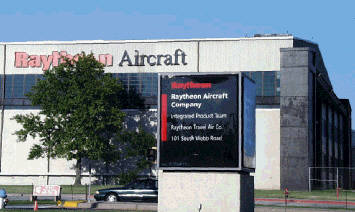
Further -- while Beech had a rich heritage in commercial and general aviation, and in building durable, reliable whole aircraft -- Raytheon was focused almost exclusively on military products: disposable missiles and various electronic devices. Raytheon was quickly in over its head in issues beyond its expertise (a fact miserably admitted years later in a corporate pronouncement). The relationship between Raytheon Corporate and Beech-Hawker (renamed "Raytheon Aircraft" promptly upon the death of Olive Ann Beech) was quickly a debacle of arrogant-meets-stubborn -- Eastern white-collar vs. Midwestern blue-collar -- and a newcomer (to airplanes) trying to boss an old pro. Resignations, high employee turnover, and labor-union troubles ensued. Relentless mismanagement of the Wichita factory by Raytheon corporate officials resulted in a deteriorating operation. Starship and Composites Attempts to modernize the King Air turboprop line showed promise, when the leading expert in advanced lightplane design -- canard / pusher / carbon-fiber composite aircraft expert Burt Rutan, brought his experimental technology to Wichita.
The Starship also introduced the revolutionary concept of "glass cockpit" instrument panels -- TV screens in places of traditional "steam gauge" aircraft instruments. However, designer Rutan, an avant-garde Californian who had never designed an actual production aircraft, did not mix well with stubborn old-line Beechcrafters, nor with stuffy Raytheon corporate hacks -- and left the company in mid-project. Raytheon shoved the aircraft through to completion, largely under the guidance of its Aircraft Division chief Walsh and engineer Walters.
By the time the Starship was completed and certified, to much acclaim, it had grown bloated from the Rutan design to a heavier plane, with more drag, that cost nearly as much as the Beechjet, but flew 100mph slower. Only about 50 sold - especially to Raytheon's own aircraft-leasing firm. Within a few years, to save Raytheon the hassle of supporting the tiny, odd fleet, all Starships were bought back, and scrapped.
Beech/Raytheon's first native jets: While Raytheon Aircraft began focusing increasingly on the
profitable commercial and military markets (more in Raytheon's field of focus
than general aviation), it leveraged the parent company's deep pockets to seize
advantage from its fleeting leadership
in carbon-fiber composites, adapting its prize technology to business jets.
Backing off from the hassles of composite wings, Raytheon kept
aluminum wings, but opted for lighter composites for the cylindrical fuselages
of its next two bizjet designs -- the
pocket-sized
Beech Premier I (above, right),
and
the luxurious "super-midsize" Hawker Horizon (now the Hawker 4000) (below, left).
From the late 1980s to the present, an avalanche of bizjet designs flooded the market, and Raytheon Aircraft struggled to find a niche -- revising and fixing its avant-garde Premier and Horizon designs repeatedly in mid-development, dragging out the process interminably. The result was a pair of advanced -- but costly, quirky -- aircraft.
The Premier turned out to have disappointing range/payload capacity, and the
Horizon, when finally in production, was clearly more costly than its top niche
competitors: Cessna Sovereign and Bombardier Continental -- both already
well-established, along with big Falcon jets by French rival Dassault,
Bad News All Around While the Raytheon composite-fuselage jets foundered, the successful
rival Bombardier Challenger bizjet (right) had evolved into the stretched Bombardier/Canadair RegionalJet (CRJ) mini-jetliner -- revolutionizing short-range airline travel, and largely
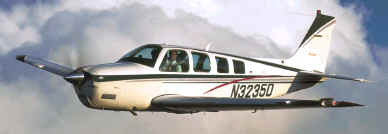
At the same time, on the lower end of the propeller market, the piston-prop Beech Bonanza (right), and Beech Baron light twin (below, left),
were being challenged by faster single-engine aircraft
-- including sleek, light composite-construction singles by Lancair/Columbia and Cirrus -- and were further threatened by
Also, the Beech piston planes suffered from the revival of briefly-defunct, older piston-single lines by Cessna, Piper, and Mooney returning to production -- supplemented further by Piper's revival of some of its most popular light twins.
But even the King Air line became a challenge to manage profitably, as light jets -- particularly from rival Wichita planemakers Cessna and Bombardier/Learjet -- grew increasingly cost-competitive with Raytheon's old-fashioned, slower, turboprop King Airs.
Other challenges beset Raytheon Aircraft -- including the torturous integration of a computer system known as "SAP", which enabled corporate headquarters to track everything throughout the company by computer -- ironically complicating and crippling nearly every activity at the factory (initially forcing a prolonged temporary shutdown of the factory in the early 2000s, with the loss of millions in aircraft sales, due to delivery problems). The SAP system, still forced onto the Aircraft Division by corporate headquarters, continued to delay and complicate most operations, and reduce productivity and efficiency. Existing owners of Beech/Hawker planes -- long famous for their brand-loyalty -- began howling about the unpredictability and difficulty getting needed parts for their planes, owing to the fouled, computerized bureacracy at Raytheon Aircraft. Many began to look elsewhere for their next purchase -- a devastating blow to an enterprise that had once been the most respected and trusted name in light aircraft.
As a string of pin-striped strangers marched in and out -- most of them with little or no prior experience in aircraft sales or manufacturing -- the management of Raytheon Aircraft degenerated into indescribable chaos, and the aircraft division collapsed in paralysis.
Raytheon Aircraft's final President, Jim
Unfortunately, Onex proved little better at running HBC than Raytheon had been. And the purchase deal, negotiated though Wall Street's most powerful (and, to some, ruthless) money-broker -- Goldman Sachs -- came at a hefty price, saddling the "new" Hawker-Beechcraft with a mountain of debt, with Goldman Sachs no doubt expecting fast and plentiful returns. 
Market unrealities
And HBC's old, warmed-over, 1960s-era,
All these lines rested on the seeming eternal preference of traditional Beech/Hawker customers for reliable, stout, roomy and familiar, proven aircraft -- over performance, advanced technology or economy. And having long ago amortized out most of these plane's development costs, it seemed a "safe" default position to continue building and selling them. However, industry analysts warned that the line was growing desperately obsolete, and HBC was not innovating well enough, fast enough, to meet evolving market realities.
The "new jets" debacle continued unabated, at HBC, as a stream of development
troubles plagued the interminable development of the all-new composite bizjets.
Though theoretically an "advanced aircraft" with its composite fuselage, the somewhat ungainly Beech Premier IA stumbled in manufacturing development, while design drift (sometimes allowing for realities not adquately anticipated at first) resulted in a plane suffering from too much weight, and too little range, for market expectations. Though it should have been a market leader in the low-end "owner-flown" bizjets -- with its speed vastly exceeding dominant rival light jets by Cessna -- Cessna essentially took the market almost completely away from the Premier with more practical, readily available, efficient and pleasant-to-fly aircraft (particularly the CJ series and even the tiny Citation Mustang). Even old used Citations proved a dampener to the owner-flown market.
By the time the Horizon (now "Hawker 4000") deliveries began, HBC's competitors had already pretty well milked the Horizon's market dry with their own in-production-and-delivered designs. Beaten to the market, the H-4000 arrived on the scene just as the recession hit, seizing up almost all bizjet markets. As if that were not enough, a national outrage had erupted over the use of bizjets by corporate executives in troubled firms. The national outcry was sparked by U.S. auto-manufacturer executives flying to the U.S. capital -- in multi-million-dollar private jets, at the height of the current recession -- to ask for billions in taxpayer-funded bailouts of their mismanaged, sinking companies. The furious public backlash drove companies nationwide, and even some abroad, to halt any further business jet purchases -- and even drove some businesses to dump some of their company jets, putting them on the market essentially in direct competition with new Hawker-Beech production.
Sales of nearly all brands of business jets -- but especially the high-dollar jets that Hawker-Beech counted upon -- ground to a near halt.
Now having fulfilled most of its contract with the military, no significant foreign customers could be found for the now-finished T-6 trainer line.

The piston line (Bonanza, Baron) continued to struggle
against the complex new world of advanced competitors,
Management-Labor Relations Onex, like Raytheon before it, addressed the company's economic issue with cost-cutting efforts, sometimes self-defeating, such as moving some elements of HBC's subassembly production to Mexico, with poor results.
HBC management continued to demand cuts and concessions -- rather than the raises workers expected for continuing to show up for work, as inflation raised their cost of living. HBC managers argued that the "market" demanded cost-cutting. But HBC was also burdened by the massive debt arranged by Goldman-Sachs in the Onex buyout, and by market-failures of its leaders and white-collar workers to develop successful new designs in a timely response to the evolving market, as industry analysts had been arguing about HBC and its forerunners for decades. Cuts in labor costs -- through outsourcing and in-house wage/benefit cuts -- were targeted by HBC management as the solution, even as they, themselves, continued to claim massive (sometimes growing) salaries, perks and bonuses -- totalling well up in the millions. In 2008, a four-week strike by the HBC machinists' union -- about a quarter of the company's workforce -- symbolized the growing aggravation of workers toward HBC owners and managers. Over the objections of many in the Wichita community, the union members dug in their heels and refused to accept the growing demands of the company. The posh rewards enjoyed by the company leadership were waved about by HBC's largely blue-collar workforce as proof that the company could afford -- or at least that the workers were due -- pay and benefit increases, not cuts. Management & Money Messes The situation was not much helped by the 2009 "resignation" of CEO Jim Schuster. Leading bizjet-industry executive Bill Boisture, Jr. took the reins. (Formerly at Hawker's predecessor, British Aerospace Corporate Jets, and later head of rival Gulfstream, Boisture also had key leadership roles at major bizjet customers NetJets and Intrepid aviation, and at leading bizjet-service company Butler Aviation. If anyone should have been considered "qualified," by a cursory look at their resume, Boisture was surely an impressive candidate to save HBC). But, despite his impressive resume, Boisture didn't (and possibly couldn't) turn things around. The market continued to flounder, as did HBC new-design development, while new and cost-competitive aircraft designs came pouring off the production lines of rival companies -- particularly Cessna, Bombardier/Learjet and rising-star Brazilian newcomer Embraer.
Going to the Governor
HBC had already shut down its Salina, Kansas parts factory, with an eye to outsourcing, and was looking at moving, perhaps, the entire propeller-aircraft line to factories elsewhere. Where, exactly, was unclear, but plenty of options existed in a hungry economy -- Mississippi, Arkansas, Texas, Mexico, India, China, etc.. This time, it didn't look like bluffing, nor huffing and puffing. It looked real. When the state of Louisiana seemingly offered massive financial incentives for HBC to move there, haplessly disorganized and bewildered Wichita-area "leaders" deferred to the leadership of Kansas Governor Mark Parkinson, who -- in negotiations that seemingly extracted hefty concessions from both HBC owners and unions -- organized a substantial bail-out package for HBC, to keep it in Kansas. Parkinson extracted a agreement from HBC leaders that at least 4,000 HBC jobs would always be in Kansas, in exchange for an injection of state aid and hefty union concessions. The promise of permanent Kansas jobs however, hardly lasted until the ink was dry on the deal. At first, things were a bit calmer around HBC. But the troubles were never-ending, and the "good news" was never-coming.
By early this year, 2012, it was growing clear that the
company was sinking into a shambles, deep in debt, with no obvious way out.
Initial negotiations resulted in Onex essentially handing the wreckage over to its creditors, including Goldman Sachs -- now the ostensible owners -- but leaving the company no more secure, and no better managed, than before. Adding insult to injury, HBC's management was given a new overlord: Sachs' apparent "chosen" "turnaround expert," Steve Miller (who was reportedly intrumental in the Chrysler bailout and turnaround in the 1970s, which included Chysler bizjet subsidiary Gulfstream, but was more involved in the acquistion and "turnaround" of various companies in recent years). Miller assured everyone in March 2012 that he didn't see any need to sell off parts of the company: “We’re going to keep this place together, continue with the product lines we’ve got and make sure we get the balance sheets structured in a way that supports us for years to come,” he said in a March 2012 interview with Aviation International News. However, that doesn't appear to have been the actual outcome of his fleeting moment of "leadership." The bankruptcy court is now looking at gutting and selling off the company, in any way that will relieve creditors -- some of them troubled companies, themselves. Suitors -- scavengers, actually -- from throughout the U.S., India and China and elsewhere have begun sniffing around the mortally wounded HBC, each deciding how much it wants to battle the other predators for a big bite of the helpless prey. Enter China: HBC's new leaders asked the bankruptcy court to approve a decision to enter "exclusive" negotiations and information sharing with Beijing Superior Aviation Technology Corp., Ltd., a Chinese firm that had previously bought a small U.S. aircraft-engine parts-maker (Superior Aircraft Parts) and a floundering, tiny Texas helicopter company (Brantly Helicopter).
WARNING: The following section of this article contains links to various media sites, including web sites of Chinese companies and Chinese government media websites. Such sites are commonly regarded by computer experts as dangerous sites to view.
Such sites are known for very aggressive abuse of the internet, including their extensive use to plant "viruses," "worms," "trojan horse" software, "spyware" and other harmful software ("malware") in your computer. Such sites are also known to involve tricks designed to cause your web browser to allow them to extract data from your computer, or manipulate your computer remotely, in the present and in the future.
Do NOT click on these links, unless:
A very secretive company, Beijing Superior is 40% owned by the municipal government of Beijing, the capital of China, and is ostensibly led by a Chinese entrepreneur, Beijing Superior's Chairman Cheng Shenzong, but the company is a mystery, a "very closely held" company, according to China Daily. Superior, nowhere nearly the size of HBC, hinted at its prior "aerospace industry" "experience" as grounds for being taken seriously as a possible buyer for HBC. What experience?
What "technology stripping" plans Superior may have for HBC are a mystery.
-- with extensive access to proprietary technological info of all three companies. Additionally, HBC has similar relations with several key aircraft-engine makers. Ignoring the MILITARY importance of such technology-transfer, there remains the heavy question of what happens when this aviation technology gets in the hands of the CIVIL aviation industry in backwards China, with its dirt-cheap labor and relatively unregulated business (which can abuse workers, bribe foreigners, pollute, lie, cheat and steal, etc, with relative impunity, compared to more-restrained American and European companies).
Final Act?
Surprisingly, the federal bankruptcy court allowed the closed-door deal, and Chinese now appear to control the fate of one of America's oldest aircraft companies -- an essential fixture in U.S. military aviation (nearly every U.S. military pilot trains in Beech/Hawker aircraft), and an historic global icon in commercial (commuter airline), business and personal aviation.
In an appeal to the bankruptcy court, in August, the executives, led by Miller, argued passionately for
With the $50 million coming from Chinese bidder Superior -- in exchange for exclusive negotiating and information-sharing rights, granted by the bankruptcy court at the urging of current HBC executives -- those exec's look ready to strip the walls and take whatever isn't nailed down, before parting out the company to whomever wants any of it. Meanwhile, Wichita-area government, business and union leaders are simply standing around, staring blankly at the slow-motion crash of one of their biggest industrial employers, their mouths hanging open --rather obviously clueless as to how to respond effectively, rationally or constructively. MORE TO COME... (Last updated: Aug 17, 2012, rev.3) |

Some of this information appeared previously in the special report "CORPORATE SNAPSHOT: Raytheon Aircraft Troubles" (including a detailed report of Raytheon Aircraft's history), in the June 11, 2001 news section of Aero-News Network.
 Return to
Return to